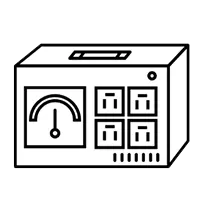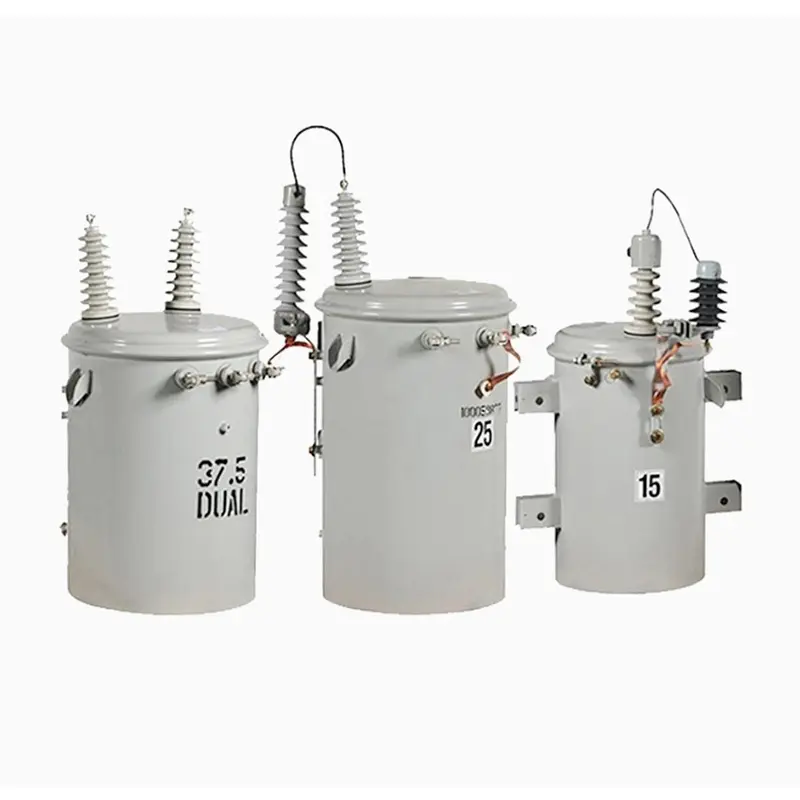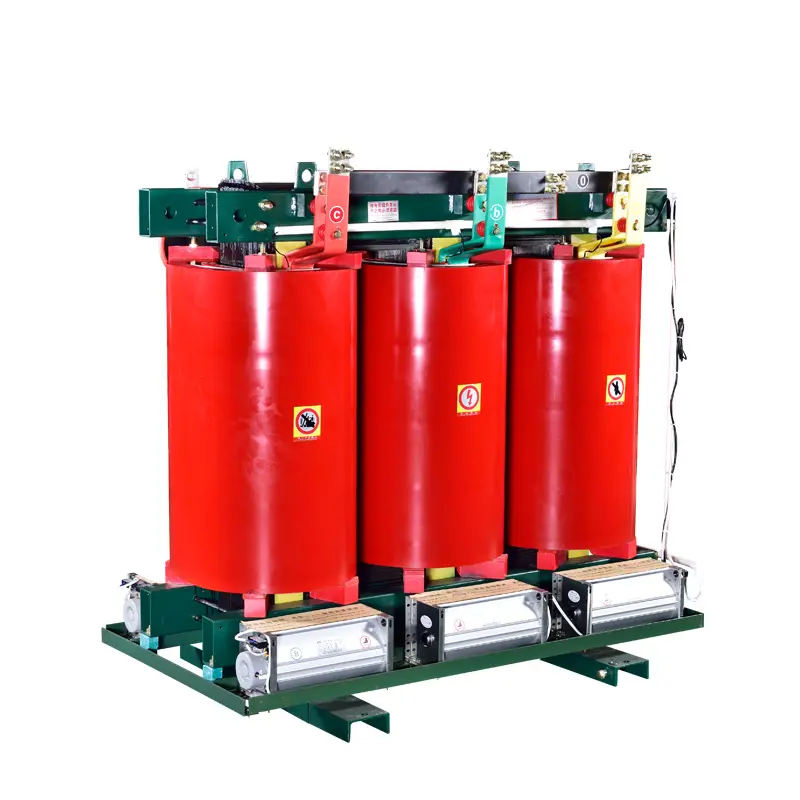Trasformatori di potenza sono una parte essenziale dei sistemi elettrici e, tra i numerosi tipi, i trasformatori trifase sono i più importanti per gli usi commerciali, industriali e di pubblica utilità ad alta potenza. I trasformatori presentano numerosi vantaggi rispetto ai sistemi monofase, soprattutto per quanto riguarda la capacità di sostenere carichi più pesanti e di garantire un'alimentazione affidabile.
In questo blog parleremo dei diversi tipi di trasformatori trifase, delle loro configurazioni e delle applicazioni tipiche. Se siete curiosi di sapere come funzionano o se avete bisogno di informazioni su come scegliere il trasformatore giusto per le vostre esigenze, questo articolo vi fornirà tutte le informazioni necessarie.
Che cos'è un trasformatore trifase?
A Trasformatore trifase è un tipo di trasformatore elettrico utilizzato per aumentare o diminuire la tensione in un sistema elettrico trifase. Questi sistemi sono ampiamente utilizzati nella generazione, trasmissione e distribuzione di energia, grazie alla loro efficienza nel fornire grandi quantità di energia. A differenza dei sistemi monofase, che utilizzano una singola corrente alternata (CA), i sistemi trifase utilizzano tre correnti alternate sfalsate di 120 gradi, fornendo un flusso di energia più stabile e continuo.
Un trasformatore trifase è tipicamente costituito da tre avvolgimenti primari e tre avvolgimenti secondari, corrispondenti a ciascuna fase del sistema. Funziona trasferendo energia tra i circuiti tramite induzione elettromagnetica, mantenendo la stessa frequenza ma modificando la tensione.
Come funziona un trasformatore trifase?
In un trasformatore trifase, gli avvolgimenti primari sono collegati all'alimentazione, mentre gli avvolgimenti secondari sono collegati al carico. Il trasformatore funziona in base al principio induzione elettromagneticadove un campo magnetico variabile nel tempo induce una forza elettromotrice (emf) negli avvolgimenti secondari, che aumenta o diminuisce la tensione.
La configurazione degli avvolgimenti del trasformatore determina il rapporto tra le tensioni primarie e secondarie, che può essere regolato in base all'applicazione.
Tipi di trasformatori trifase
I trasformatori trifase possono essere classificati in base alla loro costruzione e progettazione. I due tipi più comuni sono tipo core e tipo conchiglia trasformatori:
1. Trasformatori a nucleo
In un trasformatore trifase a nucleo, il nucleo è costituito da tre membra, ciascuna delle quali trasporta una delle tre fasi. Gli avvolgimenti primari e secondari sono avvolti sullo stesso nucleo, con l'avvolgimento ad alta tensione tipicamente avvolto intorno all'avvolgimento a bassa tensione. Questo tipo di trasformatore è comunemente utilizzato per applicazioni ad alta tensione, poiché il nucleo fornisce un forte legame magnetico tra gli avvolgimenti.
2. Trasformatori a guscio
I trasformatori a guscio sono costruiti con un nucleo che circonda gli avvolgimenti. Questi trasformatori hanno cinque arti in totale, con tre arti principali per gli avvolgimenti primari e secondari e due arti esterni che aiutano a restituire il flusso magnetico. I trasformatori a guscio offrono una migliore protezione contro fattori esterni come le sollecitazioni meccaniche e sono tipicamente utilizzati in applicazioni a bassa tensione.
Configurazioni dei trasformatori trifase
Esistono diversi modi per collegare gli avvolgimenti di un trasformatore trifase e ogni configurazione presenta vantaggi specifici. Le configurazioni più comuni sono stella (wye) e delta:
1. Configurazione a stella (Wye)
Nella configurazione a stella, un'estremità di ciascun avvolgimento è collegata a un punto neutro comune, formando una forma a "Y". Questo permette di avere una linea neutra, che può essere messa a terra, offrendo una maggiore sicurezza ed equilibrio nel sistema. I trasformatori con configurazione a stella sono spesso utilizzati in applicazioni ad alta tensione per la loro capacità di gestire un'ampia gamma di livelli di tensione e fornire un'uscita stabile.
2. Configurazione Delta
La configurazione a triangolo collega gli avvolgimenti in un anello chiuso, creando una forma a triangolo. Questa configurazione non ha un punto neutro e viene spesso utilizzata in applicazioni a bassa tensione. I trasformatori con configurazione a triangolo sono più robusti, in grado di gestire carichi sbilanciati e sono comunemente utilizzati in ambienti industriali dove sono richieste alta efficienza e affidabilità.
3. Configurazione stella-delta (Y-Δ)
In questa configurazione, gli avvolgimenti primari sono collegati a stella, mentre gli avvolgimenti secondari sono collegati a triangolo. Questa combinazione consente di ridurre l'alta tensione e di distribuire meglio il carico. È comunemente utilizzata nelle sottostazioni per la riduzione della tensione e può essere impiegata in applicazioni a media e alta tensione.
4. Configurazione Delta-Star (Δ-Y)
Questa configurazione prevede gli avvolgimenti primari a triangolo e gli avvolgimenti secondari a stella. Viene spesso utilizzata per i trasformatori di step-up nei sistemi di generazione di energia, dove sono necessarie tensioni più elevate per la trasmissione.
Applicazioni dei trasformatori trifase
I trasformatori trifase sono ampiamente utilizzati in diversi settori e industrie. Alcune applicazioni comuni includono:
- Generazione e trasmissione di energia: Utilizzati nelle centrali elettriche e nelle sottostazioni per aumentare o diminuire la tensione per una trasmissione efficiente su lunghe distanze.
- Applicazioni industriali: Essenziale per l'alimentazione di macchinari pesanti in fabbriche, acciaierie, raffinerie di petrolio e altri ambienti industriali.
- Edifici commerciali e residenziali: Utilizzati in grandi edifici commerciali, hotel, ospedali e complessi residenziali multi-unità per distribuire l'elettricità in modo efficiente.
- Energia rinnovabile: Importante per integrare nella rete elettrica l'energia proveniente da fonti rinnovabili come i parchi eolici e solari.
Vantaggi principali dei trasformatori trifase
- Maggiore efficienza: I trasformatori trifase sono più efficienti di quelli monofase, soprattutto per le applicazioni ad alta potenza. Possono gestire carichi maggiori con una minore perdita di energia, il che li rende ideali per l'uso industriale e commerciale.
- Stabilità e affidabilità: Lo sfasamento di 120 gradi in un sistema trifase garantisce un'alimentazione costante con fluttuazioni minime, fondamentale per le infrastrutture critiche.
- Design compatto: I trasformatori trifase sono più compatti e leggeri rispetto ai trasformatori monofase di pari capacità, il che li rende più facili da installare in spazi ristretti.
- Potenza bilanciata: Un sistema trifase fornisce un'alimentazione bilanciata su tutte e tre le fasi, riducendo il rischio di guasti alle apparecchiature dovuti a squilibri di tensione.
Come scegliere il giusto trasformatore trifase
Nella scelta del trasformatore trifase per la vostra applicazione, considerate i seguenti fattori:
- Tensione nominale: Assicurarsi che i valori di tensione del trasformatore corrispondano alle proprie esigenze. Il trasformatore deve essere in grado di aumentare o diminuire la tensione nell'intervallo richiesto.
- Capacità di alimentazione: Scegliere un trasformatore in grado di gestire il carico delle apparecchiature. La potenza nominale del trasformatore (misurata in kVA o MVA) deve soddisfare la domanda dei dispositivi collegati.
- Configurazione: In base alle esigenze specifiche dell'impianto elettrico, è possibile scegliere tra configurazioni a stella, a triangolo o ibride.
- Metodo di raffreddamento: I trasformatori possono essere raffreddati ad aria (AN), ad aria forzata (AF) o ad olio. La scelta si basa sulle condizioni ambientali e sulle esigenze di dissipazione del calore del sistema.
- Caratteristiche di sicurezza: Cercate trasformatori con funzioni di sicurezza integrate, come la protezione termica, gli allarmi di guasto e la protezione da sovraccarico, per garantire un funzionamento regolare e sicuro.
Conclusione
I trasformatori trifase sono essenziali per una distribuzione efficiente dell'energia nelle applicazioni industriali, commerciali e nelle infrastrutture critiche. Conoscere i diversi tipi, le configurazioni e le applicazioni dei trasformatori trifase può aiutare a prendere una decisione informata quando si sceglie il trasformatore giusto per le proprie esigenze. Sia che si debba aumentare o diminuire la tensione, un trasformatore trifase garantisce un'alimentazione stabile, affidabile ed efficiente.
Prendendo in considerazione i fattori chiave, come la tensione nominale, la capacità di potenza e le caratteristiche di sicurezza, è possibile garantire che l'impianto elettrico funzioni in modo fluido ed efficace. Se desiderate maggiori informazioni o avete bisogno di aiuto per scegliere il trasformatore trifase giusto, non esitate a contattarci.
FAQ
D1: Quali sono i vantaggi dell'utilizzo di un trasformatore trifase rispetto a un trasformatore monofase?
R: I trasformatori trifase offrono una migliore efficienza, affidabilità e capacità di gestione di applicazioni ad alta potenza. Forniscono un'alimentazione più stabile e continua rispetto ai sistemi monofase.
D2: Qual è la differenza tra trasformatori trifase a nucleo e a guscio?
R: I trasformatori di tipo core hanno tre arti con avvolgimenti avvolti su ciascun arto, mentre i trasformatori di tipo shell hanno un nucleo che circonda gli avvolgimenti. I trasformatori a guscio offrono una migliore protezione contro fattori esterni come le sollecitazioni meccaniche.
D3: Come faccio a scegliere la configurazione giusta per il mio trasformatore trifase?
R: La scelta della configurazione dipende dalle esigenze di tensione dell'applicazione e dalla necessità di un punto neutro (configurazione a stella) o meno (configurazione a triangolo). Le configurazioni ibride come stella-triangolo e delta-stella sono spesso utilizzate per applicazioni di riduzione della tensione e di step-up.
D4: È possibile utilizzare un trasformatore trifase con un'alimentazione monofase?
R: Sebbene un trasformatore trifase non possa convertire direttamente l'alimentazione monofase in trifase, è possibile utilizzare convertitori di fase o dispositivi di sfasamento per creare un'alimentazione trifase da una sorgente monofase.
D5: Quali settori industriali utilizzano tipicamente trasformatori trifase?
R: I trasformatori trifase sono ampiamente utilizzati in settori quali la produzione di energia, l'industria manifatturiera, il petrolio e il gas, l'industria mineraria e le energie rinnovabili, nonché in edifici commerciali e residenziali che richiedono un'alimentazione stabile.










